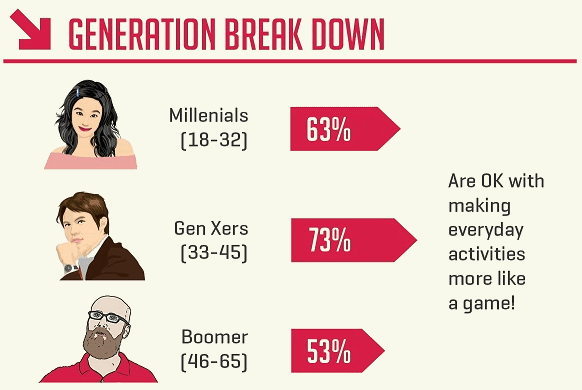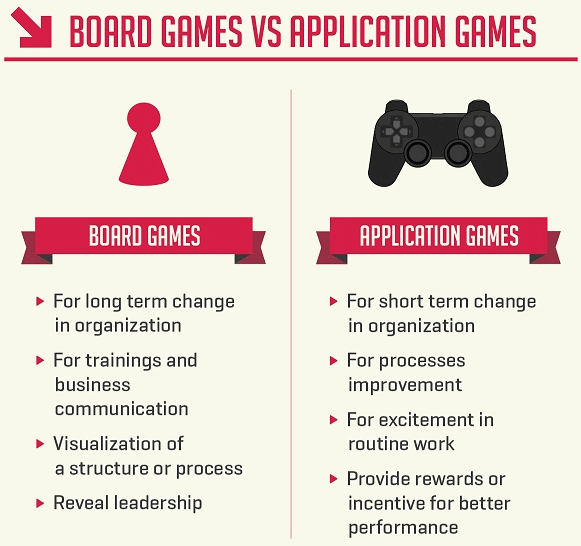In this 10th blogpost of this series guest author Dr. Karin Stumpf is connecting the dots on gamification and making some reflections on what it means to the world of business.
I Want Games! – Pleadings of a GenX Change Facilitator
I love playing. Once a week my family and I sit together around a board and enjoy each other’s company. But don’t be fooled: no hostages are being taken. For two to three hours we do everything to win. And I’m not alone. In Germany there are 37 Mill. players (almost half the population!) that, like me, enjoy the mental stimulation that goes with solving challenges, alone or with others.
We are All Equal Gamers
Commitment, teamwork, optimism, productivity are all advantages assigned to gamers, but as e.g. in the US, Generation Y and Milleniums make up for only 25% of the workforce, the question ought to be asked whether the spirit behind gamification can also be used for the GenX and Babyboomers.
First, the good news: 73% of Generation X is OK with making everyday activities more like a game. That could be repetitive tasks, the training everybody needs to attend or intra-company communication. The baby boomers are more reticent to gamification (with only 53% being OK), but their numbers in the workforce will be declining in the year to come.
The Ideal Tool for Change?
For me, as a change facilitator, a tool is only helpful if it supports individual and organizational development. And luckily business games do: they help increase our intellectual as well as emotional intelligence, they let you find new connections within the organization and they support collaboration and relation awareness. This is not only true for application based simulation but also for classic board games.
And this is not just me saying this. That children as well as adults learn important lessons about themselves and their environment by engaging in game-like activities is uncontroversial. Throughout social and behavioral science, gameplay is regarded as an important arena for the development and formation of thinking, identities building, value creation and norm setting. Topics that we as change facilitators want to help develop and actively support throughout organization.
And still around 80% of the existing games are so badly designed that they don’t fulfil their original objectives. So how can we separate the good from the bad? How can we make the right choices for our organization? And how can business games be made attractive to all generations present in our workforce?
The Ideal Business Game
Key components of a game are: goals it tries to achieve, rules that define how the players have to act, challenges the users need to overcome, and interaction between the players in and outside of their team. And these are exactly the aspects you need to look at when you review the variety of business games available in the market: does the game help us achieve our own goals? Are the game rules aligned with our own internal culture? How much interaction does the game require in and outside the team, and do these settings coincide with our requirements?
The quality of a business game also strongly depends on how well it fits the needs of the people participating. The reaction of the audience might strongly differ based on their age distribution, the seniority of the attendees, the cultural background, and the actual emotional status in the organization. Therefore the outcome of business game events can strongly differ from one to another. And what has worked once, might not work in another setting.
The needs and requirements of Generation Y and Millenium players differ from a Baby Boomer. They have had such different upbringings, that their perception of games and having fun differs drastically. In some organizations business games are being called “tools” to remove the notion of play. And because they don’t want to be seen has having fun, some executives don’t want to have games. For them business is a serious matter! You might or might not agree with that point of view, but when actively wanting to position business games in the organization, you will have to address that topic proactively.
Play yes, but not Only
Playing creates a great sense of excitement paired with immense motivation. But if employees come back to their daily work and don’t see and feel that something has changed, this energy will be lost very fast. Games’ participants can learn so much in a short time frame, getting almost instant feedback on their actions. But what happens afterwards with the learning? And what I’m trying to say is true for any singular change management action: if you don’t follow up and make it part of a larger program the achieved objectives will soon be lost in the sea of daily routines.
So yes, I want games in the workplace, but not any sort of business games and not at any random time. I want games that are fun, intellectually and emotionally challenging, that help me and the company I support develop personal skills as well as great interaction between colleagues. And I want business games that are well ingrained in the actual reality of the organization. What about you? What are your pleas regarding gamification?
Sources:
- Bureau of Labor Statistics, “Household Data, Not Seasonally Adjusted: Table A-13: Employment Status of the Civilian Noninstitutional Population by Age, Sex, and Race” (2012).
- JWT Intelligence, Data Point gamification effect (2011)
Bonus: have a look at this infographic on gamification
Series Navigation
<< Gamers Will Save Our Economy (Part 9)



